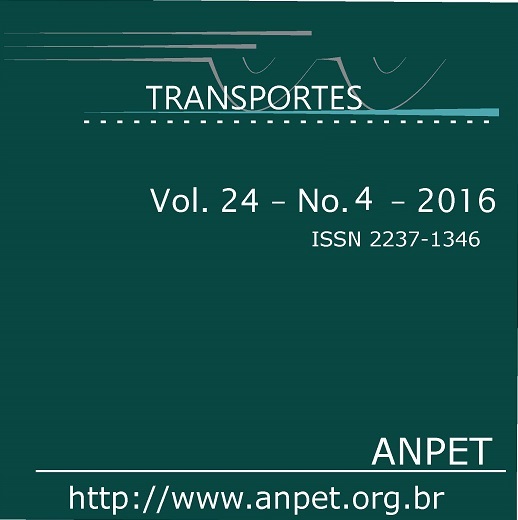Avaliação das mudanças nas velocidades das linhas de ônibus da cidade de São Paulo após a implantação de faixas exclusivas através da análise de dados de GPS
DOI:
https://doi.org/10.14295/transportes.v24i4.1008Keywords:
Exclusive bus lanes, avl data, bus speeds, monitoring.Abstract
This paper presents an analysis of the evolution of the observed speeds in bus lines of the bus service of the city of São Paulo between the periods of August 2013 and April 2015. In that period, a series of dedicated bus lanes were imple-mented across the city with the aim to prioritize the public transportation in those roads. To accomplish this, we have devel-oped an algorithm that enables us to calculate travel times of bus lines through data from on board GPS devices. The algorithm was applied to 20 weekdays in August 2013, prior to the implementation of the dedicated bus lanes, and again in April 2015, when the set of these lanes was fully operational. Two large sets of bus lines were selected to be analyzed: 68 lines that did not had any relation to dedicated lanes, and 240 bus lines that had at least a small length of their respective itineraries along dedicated bus lanes. The results show that, while the non-benefited lines had a slight average increase of 0,39% in median speeds for trips departing between 18h-19h period, i.e., in the most critical evening peak, lines from the benefited group had an expressive increase of 9,13% in their speeds. However, we also observed that the distribution of speed improvements is uneven, and some lines had reduction of median speeds during this period, in spite of dedicated bus lane benefits.Downloads
References
André, M., & Hammarstöm U. (2000). Driving speeds in Europe for pollutant emissions estimation. Transportation Research Part D: Transport and Environment, 5(5), 321-335.
CET-SP. (2013). Companhia de Engenharia de Tráfego de São Paulo. Apresentação e detalhes de metas para os corredores de ônibus. Disponível em: <http://www.cetsp.com.br/media/255662/300kmexclusivas1.pdf> Acesso em: 17 de dezembro, 2014.
Chakroborty, P., & Kikuchi, S. (2004). Using bus travel time data to estimate travel times on urban corridors. Transportation Research Record: Journal of the Transportation Research Board, (1870), 18-25.
Cortés, C. E., Gibson, J., Gschwender, A., Munizaga, M., & Zúñiga, M. (2011). Commercial bus speed diagnosis based on GPS-monitored data. Transportation Research Part C: Emerging Technologies, 19(4), 695-707.
Google Transit. (2015). Google Transit, documento de referência para desenvolvedores. Disponível em:
<https://developers.google.com/transit/gtfs/reference>. Acesso em: 29 de março de 2015.
Hennessy, D. A, & Wiesenthal, D. L. (1997). The relationship between traffic congestion, driver stress and direct versus indirect coping behaviours. Ergonomics, 40(3), 348-361.
Mazloumi, E., Currie, G., & Rose, G. (2009). Using GPS data to gain insight into public transport travel time variability. Journal of Transportation Engineering, 136(7), 623-631.
Société de transport de Montréal. Données GTFS de la STM. (2015). Disponível em: <http://www.stm.info/fr/a-propos/developpeurs/description-des-donnees-disponibles> Acesso em 17/07/2015.
Pinho, Márcio. (2014). Reportagem "São Paulo Registra maior crescimento da frota de carros em três anos". Disponível em: <http://g1.globo.com/sao-paulo/noticia/2014/02/sao-paulo-registra-maior-crescimento-da-frota-de-carros-em-tres-anos.html> Acesso 17 de dezembro, 2014.
PMSP. (2015). Prefeitura Municipal de São Paulo. Institucional, Acesso à Informação. Passageiros Transportados 2015. Disponível em
<http://www.prefeitura.sp.gov.br/cidade/secretarias/transportes/institucional/sptrans/acesso_a_informacao/index.php?p=188767> Acesso em 16/07/2015
Sptrans. (2015a), São Paulo Transportes. Indicadores. Disponível em: < http://www.sptrans.com.br/indicadores/>. Acesso em: 29 de março de 2015.
Sptrans. (2015b), São Paulo Transportes. Área de Desenvolvedores. Disponível em: <http://www.sptrans.com.br/desenvolvedores/>. Acesso em: 29 de março de 2015.
Uno, N., Kurauchi, F., Tamura, H., & Iida, Y. (2009). Using bus probe data for analysis of travel time variability. Journal of Intelligent Transportation Systems, 13(1), 2-15.
Weisbrod, G. Vary, D., & Treyz, G. (2001). Economic implications of congestion. National Cooperative Highway Research Program, Transportation Research Board. Washington, D.C.
Downloads
Published
How to Cite
Issue
Section
License
Authors who submit papers for publication by TRANSPORTES agree to the following terms:
- The authors retain the copyright and grant Transportes the right of first publication of the manuscript, without any financial charge, and waive any other remuneration for its publication by ANPET.
- Upon publication by Transportes, the manuscript is automatically licensed under the Creative Commons License CC BY 4.0 license. This license permits the work to be shared with proper attribution to the authors and its original publication in this journal.
- Authors are authorized to enter into additional separate contracts for the non-exclusive distribution of the version of the manuscript published in this journal (e.g., publishing in an institutional repository or as a book chapter), with recognition of the initial publication in this journal, provided that such a contract does not imply an endorsement of the content of the manuscript or the new medium by ANPET.
- Authors are permitted and encouraged to publish and distribute their work online (e.g., in institutional repositories or on their personal websites) after the editorial process is complete. As Transportes provides open access to all published issues, authors are encouraged to use links to the DOI of their article in these cases.
- Authors guarantee that they have obtained the necessary authorization from their employers for the transfer of rights under this agreement, if these employers hold any copyright over the manuscript. Additionally, authors assume all responsibility for any copyright infringements by these employers, releasing ANPET and Transportes from any responsibility in this regard.
- Authors assume full responsibility for the content of the manuscript, including the necessary and appropriate authorizations for the disclosure of collected data and obtained results, releasing ANPET and Transportes from any responsibility in this regard.











